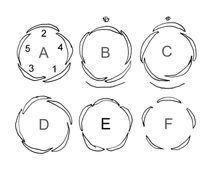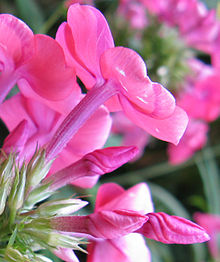- Aestivation (botany)
-
 A diagram showing some kinds of tepal aestivation in flower buds. A: imbricate; B,C: cochleate; D: contorted; E: valvate; F: open.
A diagram showing some kinds of tepal aestivation in flower buds. A: imbricate; B,C: cochleate; D: contorted; E: valvate; F: open.
Aestivation or estivation, refers to the positional arrangement of the parts of a flower within a flower bud before it has opened. Aestivation is also sometimes referred to as praefoliation or prefoliation, but these terms may also mean vernation: the arrangement of leaves within a vegetative bud.
Aestivation can be an important taxonomic diagnostic; for example Malvaceae flower buds have valvate sepals, with the exception of the genera Fremontodendron and Chiranthodendron, which have sometimes been misplaced as a result.
The terms used to describe aestivation are the same as those used to describe leaf vernation.[1] Classes of aestivation include:
- cochleate
- contorted or twisted — every petal or sepal is outside its neighbour on one margin, and inside its neighbour on the other margin
- contortiplicate
- crumpled
- decussate
- imbricate — where one petal or sepal is outside all others, one is inside all others, and the others are outside on one margin and inside on the other
- induplicate
- open - petals or sepals do not overlap or even touch each other
- quincuncial
- reduplicate
- valvate — petals or sepals touch without overlapping
References
- ^ Hickey, M.; King, C. (2001). The Cambridge Illustrated Glossary of Botanical Terms.. Cambridge: Cambridge University Press,.

This botany article is a stub. You can help Wikipedia by expanding it.

